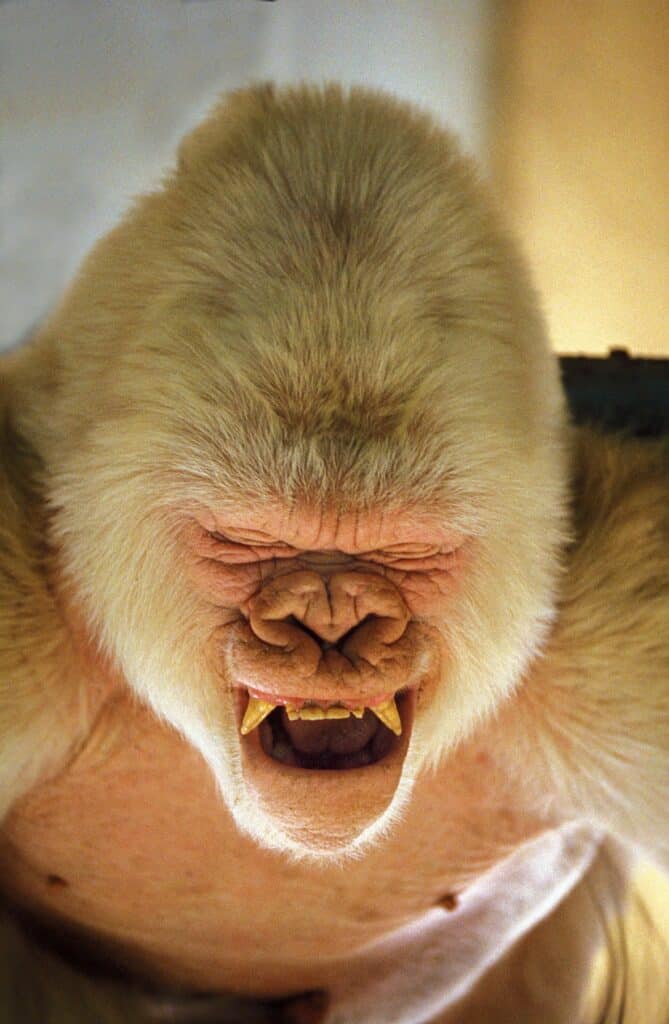White monkeys, due to albinism, are a rare occurrence among primates. Experts only have a record of a handful, making them a unique sight in the wild. Albinism is a genetic condition presenting a lack of melanin in the skin, hair, and eyes. Because of this, it can cause problems with vision and make the monkey more susceptible to sunburn and skin cancer.
Albinism occurs in both humans and animals but is much more prevalent in humans. However, a 2015 discovery of an albino spider monkey shows that primates can present with this condition.

Humans and animals with albinism can suffer from serious vision and skin problems, including skin cancer.
©Tatsiana Tsyhanova/Shutterstock.com
What Are Possible Causes of Albinism in Monkeys?
Scientists do not know what causes albinism but believe it is due to environmental and genetic factors. Inbreeding is a possible cause of albinism in monkeys, for example. Studies show that when two animals with the same recessive gene for albinism mate, their offspring are more likely to be born with the disorder.
Environmental stress may also play a role in the development of albinism.
When monkeys live under stressful conditions, such as extreme heat or lack of food, they are more likely to develop albinism.
What Are the Effects of Albinism on a Monkey?
Albinism can have a variety of adverse effects on monkeys. It can affect any body part that produces melanin, including the eyes, skin, hair, and internal organs. In monkeys, albinism can cause problems with their vision since melanin is necessary for normal eye function.
As a result, they often have poor eyesight, placing them at a disadvantage when hunting for food and avoiding danger.
Albino monkeys are also more susceptible to sunburn and skin cancer since they have no natural protection from the sun’s ultraviolet radiation. In addition, their white fur makes them stand out in the forest environment. Unable to camouflage themselves, they become easy targets for predators. Sometimes, they have trouble finding a mate and can become isolated.
One study of a chimpanzee (which is an ape, not a monkey) with albinism in the wild shows that primates may also face aggression from within their species.
What Is the Difference Between Leucistic, Partial and Complete Albinism in Monkeys?
Leucism is a pigment condition resulting in an animal’s partial or complete loss of pigmentation. On the other hand, albinism is a congenital disorder that results in an organism’s total lack of melanin pigment. Both conditions can cause animals to have white fur.
There are two forms of albinism: complete and partial. Complete albinism is a total absence of pigment in the skin, hair, and eyes. Partial albinism refers to lower levels of pigmentation or the absence thereof in the skin and hair but the normal pigmentation in the eyes.
Albino monkeys with complete albinism lack integumentary melanin (outer layers) in the retinal melanophores. This condition results in integumentary defects in the eyes. Conversely, monkeys with partial albinism have reduced or absent integumentary melanin in the retinal melanophores. But normal integumentary melanin is present in other body parts.
Partial albinism is typically less severe than complete albinism and may not cause significant vision problems. However, complete albinism can lead to vision problems such as photophobia (sensitivity to light), nystagmus (uncontrolled eye movements), and strabismus (misaligned eyes).

This olive baboon has leucism, which causes a partial or complete lack of pigment.
©iStock.com/:Bebedi
What Are the Known Cases of Albinism in Monkeys?
Despite their rarity, scientists have been documenting cases of leucism and albinism in many different species of animals, including primates, for a long time. In fact, several reports of leucistic and albino monkeys are available in recent history.
For example, in 2016, a leucistic baby spider monkey was born at the Miami MetroZoo. And in 2017, experts spotted a group of four albino macaques in a nature reserve near Bangkok, Thailand. Before that, a company was busy filming and spotted two leucistic spider monkeys in the wild near the Magdalena River valley in Colombia.
In addition, two similarly leucistic females potentially of that same species lived in the Knowland Park Zoo in Oakland, California, in the 1970s. Interestingly, they changed color from gold to white over three to four years. This case is unusual among primates and warrants further study.

Snowflake the
western lowland gorilla
was captured in the wild as an infant and lived at the Copito de Nieve, Barcelona Zoo from 1964 – 2003.
©iStock.com/slowmotiongli
However, there have been only a handful of cases of true albino monkeys reported in the scientific literature. Snowflake, the albino gorilla is often cited, but he was an ape, not a monkey. There was a famous albino monkey called Snowflake, too. Dr. Jesus Manuel Vazquez at the University of Valencia in Spain studied Snowflake for years.
This primate was a white-headed capuchin monkey born in the wild who lived until he was 26. He was one of only a few albino monkeys that scientists have ever documented in the wild.
While these sightings are intriguing, they are also somewhat concerning because primates with leucism or albinism are more susceptible to predators and other dangers. Fortunately, most leucistic or albino primate cases occur in captivity, where their carers can safely monitor and care for them.
Unfortunately, so far, there is no known cure for either condition. Still, many affected animals can lead healthy lives with proper care and treatment.
The Albino Monkeys: Spider Species of 2015
On July 27, 2015, an albino, six months old, juvenile female spider monkey underwent observation in captivity in Catacamas, Olancho, Honduras. This albino spider monkey is the first documented case of albinism in this monkey species and is invaluable for ongoing research.
A hunter caught her in the wild at San Pedro de Pisijire, Honduras. This baby spider monkey had all the characteristics of complete albinism, lacking pigmentation over the entire body surface, including the iris.
This remarkable discovery provides valuable insights into the genetics of albinism and helps us better understand this rare condition. Future research on this individual could lead to new treatments for albinism and improve our understanding of its causes and effects.
The photo featured at the top of this post is © iStock.com/kajornyot
Thank you for reading! Have some feedback for us? Contact the AZ Animals editorial team.






